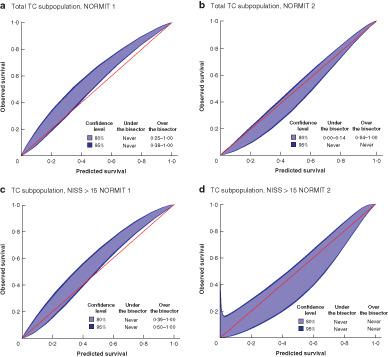当前位置:
X-MOL 学术
›
Br. J. Surg.
›
论文详情
Our official English website, www.x-mol.net, welcomes your
feedback! (Note: you will need to create a separate account there.)
Validation of the Norwegian survival prediction model in trauma (NORMIT) in Swedish trauma populations.
British Journal of Surgery ( IF 8.6 ) Pub Date : 2019-08-28 , DOI: 10.1002/bjs.11306 P Ghorbani 1 , T Troëng 2 , O Brattström 3 , K G Ringdal 4, 5 , T Eken 6, 7 , A Ekbom 8 , L Strömmer 1
British Journal of Surgery ( IF 8.6 ) Pub Date : 2019-08-28 , DOI: 10.1002/bjs.11306 P Ghorbani 1 , T Troëng 2 , O Brattström 3 , K G Ringdal 4, 5 , T Eken 6, 7 , A Ekbom 8 , L Strömmer 1
Affiliation

|
BACKGROUND
Trauma survival prediction models can be used for quality assessment in trauma populations. The Norwegian survival prediction model in trauma (NORMIT) has been updated recently and validated internally (NORMIT 2). The aim of this observational study was to compare the accuracy of NORMIT 1 and 2 in two Swedish trauma populations.
METHODS
Adult patients registered in the national trauma registry during 2014-2016 were eligible for inclusion. The study populations comprised the total national trauma (NT) population, and a subpopulation of patients admitted to a single level I trauma centre (TC). The primary outcome was 30-day mortality. Model validation included receiver operating characteristic (ROC) curve analysis and GiViTI calibration belts. The calibration was also assessed in subgroups of severely injured patients (New Injury Severity Score (NISS) over 15).
RESULTS
A total of 26 504 patients were included. Some 18·7 per cent of patients in the NT population and 2·6 per cent in the TC subpopulation were excluded owing to missing data, leaving 21 554 and 3972 respectively for analysis. NORMIT 1 and 2 showed excellent ability to distinguish between survivors and non-survivors in both populations, but poor agreement between predicted and observed outcome in the NT population with overestimation of survival, including in the subgroup with NISS over 15. In the TC subpopulation, NORMIT 1 underestimated survival irrespective of injury severity, but NORMIT 2 showed good calibration both in the total subpopulation and the subgroup with NISS over 15.
CONCLUSION
NORMIT 2 is well suited to predict survival in a Swedish trauma centre population, irrespective of injury severity. Both NORMIT 1 and 2 performed poorly in a more heterogeneous national population of injured patients.
ANTECEDENTES
Los modelos de predicción de supervivencia en los traumatismos pueden ser utilizados para la evaluación de la calidad en las poblaciones con traumatismos. Recientemente, el modelo noruego de predicción de supervivencia en traumatismos (NORMIT) se ha actualizado y validado internamente (NORMIT 2). El objetivo de este estudio observacional fue comparar la precisión de los modelos NORMIT 1 y 2 en dos poblaciones suecas con traumatismos. MÉTODOS: Pacientes adultos registrados en el registro nacional de traumatismos durante 2014-2016 fueron elegibles para el estudio. Las poblaciones de estudio eran: (1) la población total nacional de traumatismos (national trauma, NT) y (2) una subpoblación de pacientes ingresados en un único centro de trauma de nivel I (trauma centre, TC). El resultado primario fue la mortalidad a los 30 días. La validación del modelo incluyó curvas de características operativas del receptor y cinturones GiViTI de calibración. La calibración también se evaluó en subgrupos de pacientes con lesiones graves (New Injury Severity Score, NISS >15).
RESULTADOS
Se incluyeron un total de 26.504 pacientes. La exclusión por falta de datos fue del 18,7% en la población NT (n = 21.554) y del 2,6% en la población TC (n = 3.972). Los modelos NORMIT 1 y 2 mostraron una habilidad excelente para distinguir entre supervivientes y no supervivientes en ambas poblaciones, pero con un grado de acuerdo pobre entre el resultado predicho y el observado en la población NT, con sobreestimación de la supervivencia incluido el subgrupo de NISS >15. En la subpoblación TC, NORMIT 1 subestimó la supervivencia independientemente de la gravedad de la lesión, pero NORMIT 2 mostró una buena calibración tanto en la subpoblación total, como en el subgrupo NISS >15. CONCLUSIÓN: El modelo NORMIT 2 es muy apropiado para predecir la supervivencia en la población de un centro de traumatismos sueco independientemente de la gravedad de la lesión. Los modelos tanto NORMIT 1 como NORMIT 2 funcionan mal en una población de traumatismos nacional más heterogenea.
中文翻译:

挪威创伤人群中挪威生存预测模型(NORMIT)的验证。
背景技术创伤生存预测模型可以用于创伤人群中的质量评估。挪威创伤生存预测模型(NORMIT)最近进行了更新,并在内部进行了验证(NORMIT 2)。这项观察性研究的目的是比较NORMIT 1和2在两个瑞典创伤人群中的准确性。方法2014-2016年在国家创伤登记处登记的成年患者符合纳入条件。研究人群包括全国总创伤(NT)人群,以及进入I级单一创伤中心(TC)的患者亚群。主要结果是30天死亡率。模型验证包括接收器工作特性(ROC)曲线分析和GiViTI校准带。还对重伤患者的亚组进行了校准(新损伤严重程度评分(NISS)超过15)。结果共纳入26 504例患者。由于缺少数据,NT人群中约18·7%的患者和TC亚人群中的2·6%的患者被排除在外,分别有21 554和3972例需要分析。NORMIT 1和NOR 2在区分这两个人群中的幸存者和非幸存者方面表现出出色的能力,但是在NT人群中,预测和观察到的结果与高估生存率(包括NISS超过15的亚组)之间的一致性差。无论损伤严重程度如何,NORMIT 1均低估了存活率,但NORMIT 2在总亚群和NISS大于15的亚组中均显示出良好的校准。结论NORMIT 2非常适合预测瑞典创伤中心人群的生存情况,而与伤害严重程度无关。NORMIT 1和NORMIT 2在受伤患者的全国异质人群中表现较差。丧失抗药性的预防上的先决条件适用于因创伤而受凉的评估上的效用。预防超现实主义行为模型(NORMIT),适用于实际和有效的国际行为(NORMIT 2)。观察对象的客观比较NORMIT 1 y 2 en dos poblaciones suecas con conjutistismos。梅托多斯:2014-2016年杜尔门迪斯全国成人成年病登记证(Fueron elegibles para el estudio)。Las poblaciones de estudio eran:(1)全国性创伤后遗症(新罕布什尔州新创伤)y(2)全国性创伤后遗症一国(TC创伤中心)。El resultado primario fue la mortalidad los 30días。包含在模型操作员中的曲线图的验证和验证。评估伤残坟墓的等级(新伤害严重度评分,NISS> 15)。结果总计26.504名。在北卡罗来纳州立大学歌剧院(n = 21.554)和北卡罗来纳州立大学(n = 3.972)分别占18.7%和2.6%。Los modelos NORMIT 1年和2年最优秀的杰出人才永不放弃超级生存,在新奥尔良共和国的结果显示,从15岁开始,您可以在NISS上的超级生活中获得最佳成绩。总体而言,NORMIT至少保留了1个最高级别的独立性,至少在全国范围内排名第2位,而国家情报局(NSS)则超过了15个。结论:诺里特模型2享有最高法院权利,并获得了独立于精神病的精神创伤的权利。Los modelos tanto NORMIT 1 como NORMIT 2 funcionan mal en unapoblaciónde natisionalmásheterogenea。NORMIT 1个人最低生活水平估计,PERO NORMIT 2个人最高生活水平,国家情报局> 15。结论:诺里特模型2享有最高法院权利,并获得了无罪法院起诉。Los modelos tanto NORMIT 1 como NORMIT 2 funcionan mal en unapoblaciónde natisionalmásheterogenea。NORMIT 1个人最低生活水平估计,PERO NORMIT 2个人最低生活水平,国家情报局> 15。结论:诺里特模型2享有最高法院权利,并获得了无罪法院起诉。Los modelos tanto NORMIT 1 como NORMIT 2 funcionan mal en unapoblaciónde natisionalmásheterogenea。
更新日期:2019-08-28
中文翻译:

挪威创伤人群中挪威生存预测模型(NORMIT)的验证。
背景技术创伤生存预测模型可以用于创伤人群中的质量评估。挪威创伤生存预测模型(NORMIT)最近进行了更新,并在内部进行了验证(NORMIT 2)。这项观察性研究的目的是比较NORMIT 1和2在两个瑞典创伤人群中的准确性。方法2014-2016年在国家创伤登记处登记的成年患者符合纳入条件。研究人群包括全国总创伤(NT)人群,以及进入I级单一创伤中心(TC)的患者亚群。主要结果是30天死亡率。模型验证包括接收器工作特性(ROC)曲线分析和GiViTI校准带。还对重伤患者的亚组进行了校准(新损伤严重程度评分(NISS)超过15)。结果共纳入26 504例患者。由于缺少数据,NT人群中约18·7%的患者和TC亚人群中的2·6%的患者被排除在外,分别有21 554和3972例需要分析。NORMIT 1和NOR 2在区分这两个人群中的幸存者和非幸存者方面表现出出色的能力,但是在NT人群中,预测和观察到的结果与高估生存率(包括NISS超过15的亚组)之间的一致性差。无论损伤严重程度如何,NORMIT 1均低估了存活率,但NORMIT 2在总亚群和NISS大于15的亚组中均显示出良好的校准。结论NORMIT 2非常适合预测瑞典创伤中心人群的生存情况,而与伤害严重程度无关。NORMIT 1和NORMIT 2在受伤患者的全国异质人群中表现较差。丧失抗药性的预防上的先决条件适用于因创伤而受凉的评估上的效用。预防超现实主义行为模型(NORMIT),适用于实际和有效的国际行为(NORMIT 2)。观察对象的客观比较NORMIT 1 y 2 en dos poblaciones suecas con conjutistismos。梅托多斯:2014-2016年杜尔门迪斯全国成人成年病登记证(Fueron elegibles para el estudio)。Las poblaciones de estudio eran:(1)全国性创伤后遗症(新罕布什尔州新创伤)y(2)全国性创伤后遗症一国(TC创伤中心)。El resultado primario fue la mortalidad los 30días。包含在模型操作员中的曲线图的验证和验证。评估伤残坟墓的等级(新伤害严重度评分,NISS> 15)。结果总计26.504名。在北卡罗来纳州立大学歌剧院(n = 21.554)和北卡罗来纳州立大学(n = 3.972)分别占18.7%和2.6%。Los modelos NORMIT 1年和2年最优秀的杰出人才永不放弃超级生存,在新奥尔良共和国的结果显示,从15岁开始,您可以在NISS上的超级生活中获得最佳成绩。总体而言,NORMIT至少保留了1个最高级别的独立性,至少在全国范围内排名第2位,而国家情报局(NSS)则超过了15个。结论:诺里特模型2享有最高法院权利,并获得了独立于精神病的精神创伤的权利。Los modelos tanto NORMIT 1 como NORMIT 2 funcionan mal en unapoblaciónde natisionalmásheterogenea。NORMIT 1个人最低生活水平估计,PERO NORMIT 2个人最高生活水平,国家情报局> 15。结论:诺里特模型2享有最高法院权利,并获得了无罪法院起诉。Los modelos tanto NORMIT 1 como NORMIT 2 funcionan mal en unapoblaciónde natisionalmásheterogenea。NORMIT 1个人最低生活水平估计,PERO NORMIT 2个人最低生活水平,国家情报局> 15。结论:诺里特模型2享有最高法院权利,并获得了无罪法院起诉。Los modelos tanto NORMIT 1 como NORMIT 2 funcionan mal en unapoblaciónde natisionalmásheterogenea。











































 京公网安备 11010802027423号
京公网安备 11010802027423号